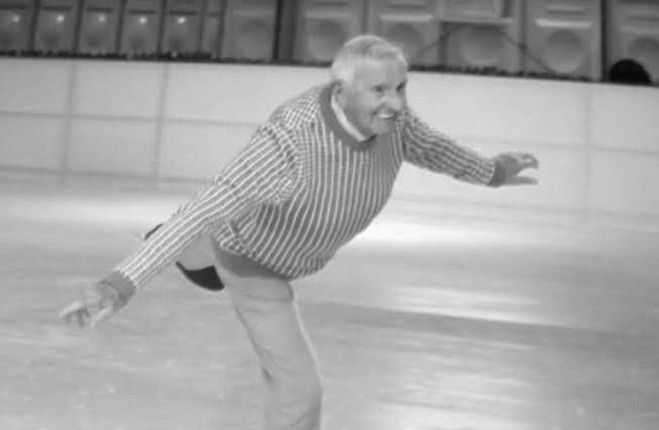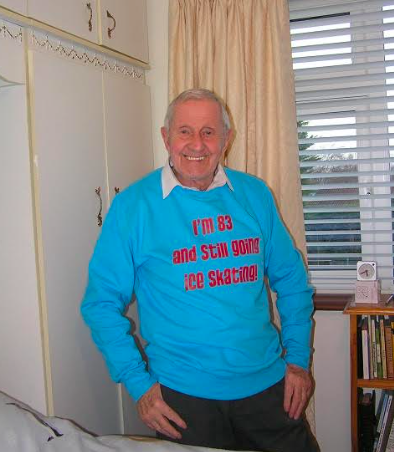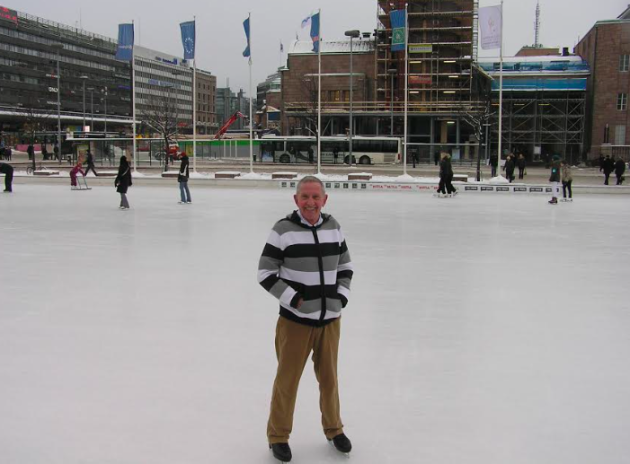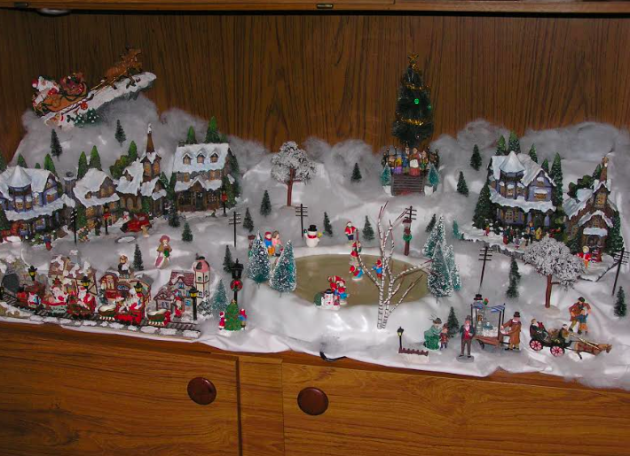SOMETIMES A STORY just falls in your lap and you feel compelled to follow the trail.
That’s what led me to Ron Warren.
Deep in some research recently, I came across a video online. It was an episode of RTE’s Jo-Maxi from July 1989 and had Ray D’Arcy filing a report on the Dolphin’s Barn ice rink, located deep in Dublin’s south inner-city. For the most part, it’s a pretty standard piece. Ray’s interviews with talented young skaters is interspersed with some footage of them on the ice. Ray gets some lessons himself and hilarity inevitably ensues.
But about a minute in, the soundtrack pivots from quintessential drum machine 80s pop to a soft string arrangement and the camera follows one older man – in a patterned grey sweater – alone on the ice, as he performs an array of dance steps.
I was desperate to find out who he was and where he learned to skate like that.
Full disclosure: with an obsessive figure skating fan as a wife, I’ve spent the last 14 years immersed in a world of axels, quads, twizzles and salchows. Like we’re old pals, I’ve been on first-name terms with the sport’s elite talent for a while: Tessa, Scott, Evgenia, Nathan, Piper, Paul. I’ve watched my wife collapse into a blubbering heap as she melted into Virtue and Moir’s Moulin Rouge Olympic free dance. I’ve watched my wife fume at judge’s marks, immediately and angrily scroll through her phone and blast the GOE (Grade of Execution) or PCS (Program Component Scores) that an ice-dance couple has received. I’ve watched my wife break down – with spectacular precision (no easy feat) – the Finn Step. I’ve watched her sit in silence, carefully mulling over the details of the latest Russian skating melodrama. I’ve watched my wife gleefully reveal that a Russian-speaking colleague has offered to translate social media updates from those at the centre of said latest melodrama. I’ve watched my wife jump on a video WhatsApp call with her sister, flip her phone around and prop it up on a living room table so the Canadian coverage of the latest Grand Prix skating event (we live in Toronto) can also be viewed from Crumlin.
My wife has travelled the world to watch figure skating and there are many, many deeply worrying but pretty entertaining stories of the spectacular lengths she and her sister have gone to feed their needs (pen pals, online forums, fan letters, exhibition events in Albany, New York, World Championships in Dortmund, Winter Olympics in Vancouver – y’know, the basics). When somebody finds out about the scale of the obsession, the usual reaction is something along the lines of, ‘Skating? But you’re Irish. What? How? Why?’ Not necessarily in that order. So, Irish figure skating fans – and I mean hardcore fans – are a deeply rare breed.
So, in many ways, the man in the video seemed a kindred spirit. And eventually I tracked him down.
“I used to go to my local cinema here, the Classic in Terenure”, Ron, now aged 83, told me.
“The building is still there and it’s a furniture place now. It was just up the road from my mother’s store – my parents were shopkeepers – and it was also close to my school, which was around the corner. But it was 1943 – when I was seven years old – that I went along to see a famous Norwegian girl called Sonja Henie, who was a three-time Olympic figure skating champion – and she started me off. It was one of her movies called Wintertime and then a few years later, in 1948, I saw her again in another film called The Countess of Monte Cristo. And I’d never seen anything like it. I couldn’t believe it. She was performing on an ice surface and it was all new to me.”
From that moment, Ron was hooked. After working with a company called Amalgamated Cinemas in Dublin for a number of years, his goal was to move to London and become an assistant manager with Circuit Management Associations, the organisation that managed various chains of ballrooms, dance-halls and cinemas. So, at the age of 22, he headed for the bright lights… and a multitude of ice rinks.
“I went over in 1958 and it was there that I could finally take up skating,” he says.
There was Queen’s Ice Skating Rink and another magnificent one in Streatham, which wasn’t too far away from where I was living. So I’d visit regularly and I actually bought my first pair of skates there too. But I took my lessons at Queen’s and we’d learn various steps for dance sequences. I was entranced by the movement. And for me, as a male skater, it was all about the speed. It was amazing to think you could pick up so much speed on an ice surface and that really intrigued me. The quicker I could get on the ice, the better. But then I progressed to being able to go backwards and sideways and then I started to incorporate some spins into it as well.”
“I was into the jumps but I never developed the ability to do doubles or triples (fully rotating twice and three times once you’re in the air). In the skating world, I was considered an old man at 22. Right now, you have some female skaters who are as young as 14 and 15 and doing quadruple jumps. But even in pairs skating, they’re talking about the male partner throwing the female into the air for five rotations. Now, is there not a limit to this? I’d prefer to see them making graceful movements.”
Ron returned to Ireland in 1967 but there was a substantial snag to the homecoming: no place to play in his own backyard.
“When I came back to Dublin, I didn’t have a rink to visit so I used to go to the King’s Hall in Belfast,” he says.
“At that stage, there was no motorway so it could take three or four hours to get there by car, through the various byways. But then, a godsend and the Dolphin’s Barn rink eventually opened up in the early eighties. Terenure to Dolphin’s Barn was nothing, in terms of getting around. I had a Heinkel scooter at the time and I’d drive down, park outside and off I’d go. The rink was a converted cinema but well run by the two brothers who owned it. But the only thing was that it was very difficult to get skating instructors. And when we did get them, it was two girls from Northern Ireland who’d come down from Belfast, and even further afield, to help us get better on the ice.”
By the early nineties, Ron had sourced a company that specialised in arranging trips to various skating events including European and World Championships. And in March, 1991, he made his first pilgrimage. And it was a baptism of fire in Munich too, as he was there for a very memorable Ladies short programme, a field that included Nancy Kerrigan, Tonya Harding and Kristi Yamaguchi. But they didn’t grab the headlines that day: Midori Ito did.
“Ito was a wonderful Japanese skater and I remember the moment like it was yesterday”, Ron begins.
“It was the most exciting exit from a rink that I ever saw. Earlier – before Ito’s performance – she had her warm-up and she and another skater collided. She was taken off the ice but she was still okay to compete. But then, during her performance, she landed her double-toe loop combination jump but was too close to the opening in the boards and she fell backwards on top of a cameraman. And I was standing right there, ready with a bunch of flowers to give to her once she had finished her routine. So, of course, I dropped the flowers and I took the Lord’s name in vain. I just screamed out, ‘Jesus’ and I nearly died. The whole crowd were absolutely stunned. But what an athlete Ito was. She jumped right back into the rink and continued the performance. It was incredible.”
It was in Munich that he experienced a particularly special thrill. He’d been rendered speechless – along with hundreds of millions of others – as he watched Torvill and Dean’s ‘Bolero’ ice-dance routine at the 1984 Olympics in Sarajevo, one of the most iconic sports moments of all time. And seven years later, as the Nottingham pair enjoyed retirement (they’d be coaxed back for the Lillehammer Olympics in 1994), Ron met them and picked up their treasured signatures too.
“When that performance of Bolero happened, it was absolutely incredible”, he says.
“The idea they had, the concept and what they put into the choreography… it was magnificent. And, as many people know, the length of the music was an issue. Even though they had condensed it down, it was still 18 seconds too long under Olympic rules. But, they were so clever and found that the performance was deemed to have begun only when their blades touched the ice. So that’s why they begin the routine on their knees. And they had this choreographed intro for 18 seconds that was so radical. I went to see them perform it at an event in Belfast and the place gave them a rousing reception. A standing ovation. Amazing.”
Ever since, Ron has been around the globe to witness various competitions. But one planned skating trip still causes him immense regret.
“It was 1992, everything was taken care of and I was going to head for America and the World Championships in Oakland, California”, he says.
“At the time, I was working with AVIS, the rental car company, in Dublin. And would you believe that two months before the trip, AVIS left Ireland and I lost my job. I had to cancel the visit to Oakland and it was just the worst year. I was absolutely broke and I just thought there was no use to go all the way over there if I couldn’t do anything once I arrived.”
Still, he quickly made up for the disappointment. Effectively, any holiday he takes must incorporate a multitude of visits to a local rink. And he proudly lists off the various locations where he’s sampled the ice: New York (Central Park, Rockefeller Centre and the Sky Rink at Chelsea Piers -’ a huge place’, according to Ron), Munich, Vienna, Zagreb, Helsinki, Bern, Nice and Sheffield. And that’s just for starters.
“I’ll go up to Dondonald Ice Bowl in Belfast on the train now”, he says.
“Two and a half hours to get there, a taxi from the station and the same arrangement coming back.”
For a while, he didn’t have to travel as far to get his fix. But the Dundalk Ice Dome has been closed since 2010, something he feels is a missed opportunity.
“It was a beautiful rink”, he says.
It was almost Olympic size and it had seating for different shows and for hockey games. It’s still vacant up there and somebody got onto me recently to they’re ready to open it again soon. But I had to reply by saying, ‘I’ll believe it when I see it’. It’s amazing that we don’t have a rink anymore. I remember some of the brilliant skaters at Dolphin’s Barn and one of the parents gave an interview at the time and said, ‘People have no idea what talent is in the rink right now’. And the kids didn’t even get half a chance to succeed because there was such a lack of instructors and resources. Even now, with a skater like Conor Stakelum who’s competing in many competitions for Ireland, he has to base himself in Dundee to train and it’s so sad.”
In Dublin, Ron has to make do with the various skating pop-ups at Christmas time. But they’ve proven problematic for a few reasons.
“We’re inundated with them and they tend to be very overcrowded”, he says.
“And the other issue is maintenance. I had a lousy fall at one of them when condensation dropped from the netting at the top of the temporary rink and formed a small bump on the ice. If you don’t have a Zamboni (an ice resurfacing machine), the bumps don’t get smoothed out. So instead, you have the stewards going around trying to clear up these bumps with a tiny stick but then you’re left with holes in the ice. Anyway, it was 2014 and I was doing a dance step with my right foot forward, my left foot back and my two arms back and I hit the bump on the ice. I was going at quite a speed and it flung me face-first and put my shoulder out of commission.”
There was a second incident in Dublin – a collision with another skater, a la Midori Ito in 1991 – that also left him battered and bruised. But still, he remains as obsessed as ever and is busily planning a trip for 2020.
The obsession is so strong that figure skating even plays a substantial part in his Christmas decorations.
“I create this little village for Christmas and display it on the sideboard here in the house”, he says.
“There are some magnetised skaters and when you switch the display on, some music plays and they’re able to move around on the rink. The kids from next door come in to have a look and they really love it because there are various other accessories that I’ve picked up down through the years. Some little houses, Christmas trees with the lights and Santa and the reindeers.”
But, in keeping with his entire life, it’s the ice rink that takes centre stage.
The42 is on Instagram! Tap the button below on your phone to follow us!





